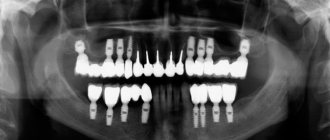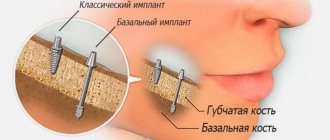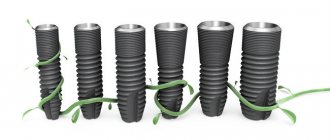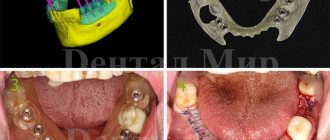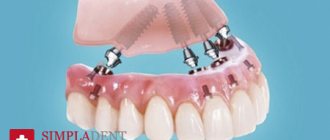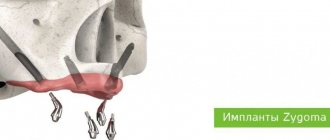- 3d dental implantation
- Basal dental implantation
- Non-surgical dental implantation
- Dental implantation
- Two-stage dental implantation
- Dental implantation
- Teeth replacement
- Implantation of 1 tooth
- Implantation into the root of the tooth
- Implantation of upper teeth
- Implantation of all teeth
- Implantation of chewing teeth
- Dental implantation all on 4
- Dental implantation all on 6
- Dental implantation under general anesthesia
- Dental implantation under sedation
- Dental implantation with immediate loading
- Dental implantation with plastic surgery
- Implantation of jaw teeth on a turnkey basis
- Implantation of molars
What is basal implantation?
Let's try to give an analogy to make it clear what basal implantation is. If you place a stick in the ground using only the top loose layer, it will not hold well. But if you use deeper layers that are not washed out by water or exposed to other external influences, the stick can be secured much more firmly and will last longer. The same goes for basal dental implantation.
Basal complex is a type of implantation in one stage with immediate loading. The main difference between the basal implantation method and other protocols is that the installation of implants does not require the presence of alveolar cancellous bone, the most central part of the jaw bone tissue. It is used to install most classical implants. Basal implants work with fundamentally different sections: the cortical plate, basal bone, buttresses of the skull, nasal, zygomatic and sphenoid bone. To ensure that the bone and implant have a large contact surface, artificial roots are installed at a certain angle. Angling also helps to select the most suitable areas of bone and place implants bypassing the sinuses and nerve endings.
Unlike classic implants with a rough surface, basal implants are smooth and have a special antimicrobial coating. According to many studies, it is the absence of a rough surface in combination with the use of deep bone sections for implant installation that is an excellent prevention of peri-implantitis and, as a result, minimizes the risk of rejection in the long term. This is especially true in the presence of inflammatory processes in the oral cavity and periodontal tissues in particular.
The method is ideal for patients with complete edentia and is not suitable if only one tooth needs to be restored. The minimum is three missing teeth.
Stages of basal implantation
- Stage one is diagnostic
. Its duration is 1-2 days, in rare cases - about a week. During this time, the doctor will conduct an examination of the condition of the bone tissue (x-ray of the entire jaw, computed tomography or volumetric study of the bone), and the teeth preserved in the oral cavity. Do not forget to tell the doctor yourself about all existing diseases of the body; this will help reduce possible complications after surgery. - Stage two - treatment modeling
. After the doctor has examined the bone tissue, he selects the implants according to shape and size and determines the angle of their fixation in the oral cavity. Then comes the stage of agreeing with the patient on the treatment method and concluding a contract (by the way, we recommend paying attention to general manipulations: the price will include not only implants and prostheses, but also all additional procedures - anesthesia, sanitation of the oral cavity, taking impressions, fitting the prosthesis, repeated appointments after installation of artificial teeth). - Stage three - installation of implants
. If necessary, an individual surgical template is created according to which the implants will be installed. The structures are fixed in the bone in a minimally invasive way, that is, without any tissue incisions, by puncture. Moreover, with this method of installing one’s own bone tissue, a minimal amount is lost, which is again beneficial for patients with atrophy that has already begun, when every millimeter is important. No stitches are required after surgery. - Stage four - prosthetics
. The primary stability of basal implants, as well as a minimum of surgical intervention, allow prosthetics to be performed 2-3 days after their installation. In addition, basal implants have a one-piece structure (the abutment or the top of the structure is integrated with the intraosseous part), so additional time is not required for the healing of the internal part first, and then the installation of the supragingival element. Dentures are created individually, using pre-made impressions of metal roots immediately after their installation. The patient can choose absolutely any materials (prostheses made of metal ceramics or more expensive zirconium dioxide).
In some cases, the doctor may recommend the installation of temporary prostheses (crowns) for a period of 6 months to 3 years, followed by the installation of permanent structures.
Basal method of dental implantation - indications and contraindications
The main restrictions on refusing basal implantation are the absence of 1–2 teeth, as well as general contraindications to any other surgical intervention. At the same time, Basal complex allows you to solve problems that classical implantation cannot solve.
Indications for basal implantation are complete or multiple absence of teeth, which is accompanied by the following problems and needs:
- advanced forms of periodontitis and other dental diseases, when the only way out is their removal, for example, with a high degree of mobility or loss, in the presence of strong cystic formations on the roots;
- acute and chronic forms of gum disease, accompanied by severe recession of the gingival contour and exposure of the roots;
- inflammation and acute atrophy of spongy bone tissue;
- desire to change dentures to implants;
- the need to speed up treatment;
- reluctance or inability to grow bone;
- advanced age of the patient;
- restoration of teeth in experienced smokers.
More services in the area of dental implantation in Orel
- Implantation of tooth roots
- Implantation of lower teeth
- Front teeth implantation
- Implantation in the absence of 3 teeth
- Implantation for periodontal disease
- Implantation of an extracted tooth
- Dental enamel implantation
- Classic dental implantation
- Complex dental implantation
- Consultation with an implantologist dentist
- Bone implantation of teeth
- Laser dental implantation
- Mini dental implantation
- Gum extension
- Bone augmentation with dental implants
- One-stage dental implantation
- Single-phase dental implantation
- Gum plastic surgery after implantation
- Dental plastic surgery
- Re-implantation of teeth
- Full dental implantation
- Full jaw implantation
- Dental implant repair
- Sinus lift
- Sinus lifting with simultaneous implantation
- Implant removal
- Installation of teeth
- Implant installation
- Express dental implantation
Dental implantation in Orel - telephone numbers of registries, websites and addresses of clinics, customer reviews and ratings of centers for pediatric, adult and family dentistry. Opening hours of clinics, questions and answers, photo and video presentations. Prices for the turnkey dental implantation service.
Features of the Basal complex
- No bone grafting is required.
- Basal implantation and tooth extraction are easily combined and are carried out in just one approach.
- Before the operation, a thorough 3D diagnosis is carried out, as well as three-dimensional modeling of the treatment process.
- At the surgical stage, templates are used to facilitate the process of implantation and allow their installation to be carried out as accurately as possible. During the implantation process, all manipulations are also monitored using 3D X-ray diagnostic technologies.
- Prosthetics take place within 3 days to ensure chewing load on the bone. Dentures can be fixed to implants using either cement or screws.
- When using zygomatic implants, they are fixed at an angle, bypassing the maxillary sinuses.
- For basal implantation, solid one-piece or one-component implants are used in an amount of at least 8 pieces.
How is basal implantation performed?
Before performing basal implantation, the dentist examines the patient’s oral cavity and prescribes an orthopantomogram and computed tomogram. This will allow you to evaluate the structure, bone density, and calculate the required distance between the implant installation area and adjacent teeth. Ideally, the surgeon should create a 3D model for accurate implantation, but not all specialists do this.
After a comprehensive examination and test results, dentists carry out, if necessary, sanitation of the oral cavity, treatment of pathologies of teeth and gums. If there are no contraindications, a one-stage basal implant procedure is performed.
Proponents of basal implants argue that their installation is a low-traumatic process for patients. Classical implantation involves extensive drilling of the cancellous bone and the need to open the gums to place a large-diameter implant. With basal implantation, the surgeon must not only peel off the mucosa and periosteum, but also cut into holes deep into the basal layers of the bone. Therefore, the healing process will be extremely painful and will take at least two weeks.
If a specialist has created a 3D model, then special stencil templates, prepared in advance using modeling programs, are placed on the gums. An implant with a permanent abutment is screwed through the holes in the stencils at an angle. This process is carried out even immediately after tooth extraction.
Basal implants are a one-component, non-separable titanium root system with a periosteal abutment. Their installation takes only 20-30 minutes and is carried out under local anesthesia. After 3-4 days, the surgeon begins the prosthetic stage, putting on a permanent crown with a load instead of a temporary one. Thus, dental restoration is completed in one week. And this is the main decisive point for some patients who do not want to wait for the long-term implantation of a classic implant for many months and undergo bone grafting.
Types of implants for the basal method
Why does the installation of basal implants take place without bone grafting?
Classic two-stage dental implantation is only possible if there is a sufficient amount of cancellous bone tissue. If there is a deficiency, bone augmentation is required before surgery. The basal method does not require this. Everything is explained simply:
- Other layers of bone are used, the density and hardness of which does not change due to the absence of teeth, since their chemical structure is different from the alveolar (spongy) layer.
- For the basal method, solid implants are used. They are often longer and thinner than the classic two-piece. This allows implants to be installed into the bone tissue at an angle with penetration into the deep layers.
- Basal implants are installed according to the principle of compression of bone tissue around its axis when screwed. That is, during implantation, the bone is not lost, but is compacted around the artificial roots. In this way, excellent primary stabilization is achieved with a force of up to 100 Newtons (for comparison: with the classical approach - no more than 30 - 40 Newtons). This approach has been used for more than 50 years for fractures and joint injuries. The principle of operation is also known by the name of the scientist-inventor G.A. Ilizarov.
- After fixing the implants in the bone, metabolic processes are immediately activated. The solution to this problem is taken over by the prosthesis. The patient chews food, improving blood supply to bone tissue. The cells are revived, replacing old and damaged ones, filling the space and increasing bone density around the artificial roots. Osseointegration occurs faster.
- The prosthesis has another important task - to fasten, connect or splint the implants with its frame, thus eliminating the risk of their mobility and displacement of the structure. The metal base connecting the implants to the prosthesis does not change its position even under heavy loads.
Alternative to basal implantation
The dental clinic "Yulistom" values its reputation and offers its patients only reliable, high-quality, painless dental restoration. We use the latest modern technologies, recognized by clinical recommendations of world dental associations.
Single-stage implantation using the endosseous method
This is an express method that allows you to restore an extracted tooth in the shortest possible time. It is carried out in one, maximum two stages, immediately after the removal of a diseased tooth, when the bone tissue has not yet had time to atrophy. It will take 2-6 months for the implant to heal.
It is considered the most physiological method that allows you to completely restore all the functions of a lost tooth, preventing a decrease in the volume of bone tissue. It differs from basal technology in that it is implanted not into the deep layers of the bone, but into the spongy layer.
Its advantages are:
- speed of tooth restoration – in 1-2 visits to the doctor;
- cost-effective procedure.
The downside is the impossibility of performing one-stage implantation using the intraosseous method in the presence of an inflammatory process or jaw injury.
One-step protocols
The classic implantation protocol is carried out in two stages with a break of several months between implant installation and prosthetics. This method, although it takes a long time, is reliable and time-tested.
The difference between one-stage protocols and the classic one is the reduction in time for treatment and restoration of missing teeth. In most cases, patients do not have to wait for the socket to heal; crowns are installed immediately - in one stage, the treatment period is reduced to 4 months.
The best solutions for one-stage implantation are:
- All-on-4 protocol – provides prosthetics on four implants, Nobel and Straumann products are used. Performed when there is slight atrophy of the alveolar ridge. Prosthetics using the “All-on-4” method will take 1-7 days, healing of implants will take up to 6 months;
- All-on-6 protocol – implantation of 6 implants per jaw is necessary for more severe bone atrophy. With this method, the survival rate of implants is from 2 to 4 months in the lower jaw, from 4 to 6 in the more porous upper jaw;
- zygomatic implantation – implants extended to 60 mm are used, which act as substitutes for tooth roots; they are installed deep into the cranial bones, which are not subject to atrophy. Thanks to them, you can do without bone grafting and sinus lifting, but their fixation is possible only on the upper jaw. The orthopedic system is installed in 1-3 days, the implants take root within six months.
There is also the so-called intramucosal or intramucosal implantation. To achieve this, mini-implants are used. They are necessary for interprosthetic fixation or securing a removable denture. They are used in situations where it is impossible to place permanent implants, in cases of bone tissue deficiency, palate defects, and the impossibility of surgical intervention.
Trefoil or All-on-3
This “All on 3” technology has received the name “trefoil” among dentists. This is one of the newest immediate loading implantation techniques proposed by the American-Swiss company Nobel Biocare. It has been actively implemented in Russia since 2022.
Treifol prosthetic technology
As scientific studies have shown, Trefoil is considered so far the most effective intraosseous prosthetic method, allowing dental surgeons to solve the most complex problems.
For All-on-3 implantation, only three implants are used, which are immediately installed vertically in the frontal area without subsequent re-prosthetics. The technique requires a highly qualified doctor, mandatory 3D diagnostics and bite correction by aligning the jaw bone of the lower jaw. The three implants are connected by a titanium bar, customized individually for each patient.
The advantages of Trefoil are:
- restoration of damaged dentition in one day with a permanent prosthesis;
- procedure without bone grafting;
- perfect positioning of rods with a high degree of fixation;
- rapid adaptation due to the location of the dentures not on gingival tissue, but on implants.
The only drawback of the All-on-3 implant system is the impossibility of installing it on the upper jaw.
Classic two-step method
Traditional two-stage or classical implantation, despite the introduction of new one-stage techniques, still remains a popular service. This is a reliable technology, actively used since the 80s of the 20th century, and is still at the top of dental restoration techniques.
Classic implantation with delayed loading is carried out in two stages:
- In the first stage, the surgeon cuts the gum and inserts a dental implant into the jaw bone. After which the gum is sutured and a break of 3 months to six months is required for osseointegration of the rod into the bone tissue.
- After the artificial roots have implanted, the gum is cut again, a gum former is screwed into the implant, and a permanent prosthesis is installed on it.
Two-stage implantation is used in cases of missing one or more teeth in a row, with partial or complete edentia, to restore the lower and upper dentition. Patients and dentists value this technology for its reliable, almost lifelong fixation, aesthetic appearance, and always guaranteed results.
The disadvantages include:
- long period of dental restoration – 2-6 months, with bone grafting – up to a year;
- the procedure is traumatic, in most cases – the need for osteoplasty;
- high risk of inflammation and long survival of implants in a number of diseases, for example, diabetes, as well as in old age.
Types of implants used
Manufacturers offer dentists a wide range of implants made of ceramic, titanium and zirconium in various shapes. Depending on the density of bone tissue and the size of the alveolar process, a design can be selected for the patient according to his parameters.
Implants vary:
- Intended use : intraosseous (attached to the jaw bone);
- extraosseous (installed in the periosteum, in the gum).
- root-shaped (intraosseous, for installation in the alveolar process);
- one-piece and mini-implants (non-separable single design of root and abutment);
For the consumer, the class of implants (economy, business, premium) and the manufacturer’s brand are also of no small importance.
| Class | Brand |
| Economy |
|
| Business |
|
| Premium |
|
The leaders in the ranking of implant manufacturers are:
Nobel Biocare
The American-Swiss company accounts for 40% of world dentistry. Produces high-quality, low-impact products made of pure titanium coated with TiUnite. Guarantees 100% survival rate.
Straumann
A Swiss manufacturer with over 40 years of experience produces 350 types of implants, most of which are intended for immediate implantation. Promises a 20-year warranty on its products.
Hi-Tec
Israeli products made from technically pure grade 4 titanium. Their surface is sandblasted and acid etched. This increases the survival rate of the implant in the bone and reduces the risks for the patient.
Astra Tech
Innovative technologies guarantee a high survival rate of up to 99%. The products provide excellent long-term results with one-stage and two-stage surgical protocols.
MegaGen
Korean implants were able to supplant the Swiss, American and German leaders in implantology. The line of implantation systems from Korea is offered at reasonable prices, not inferior in quality and reliability to business-class products from European manufacturers. The AnyRidge series with Xpeed coating and Knife Tread has performed particularly well, with a survival rate of 99.2%.
Pros and cons of basal implantation
- Time frame – prosthetics using this method will not take the patient much time. According to the protocol, implants should be “loaded” on day 3. Maximum taking into account the need to prepare for the operation, with all possible corrections of the prosthesis to suit the patient’s bite, compliance with the requirements for aesthetics and beauty of the smile, the entire treatment will take no more than 7 days.
- Appearance - the artificial gum is made of translucent acrylic, there is very little of it. When smiling and talking, no one will notice the border of the prosthesis. And the base will brilliantly cope with its task - it will protect the gums from injury in case of inflammation and hide existing cosmetic defects of the mucous membrane, if any.
- Rejuvenation is a pleasant “side” effect of prosthetics. Wrinkles around the mouth will be smoothed out due to the normalization of the functioning of the facial muscles.
- Pleasure from food - you can eat everything! Chewing food is welcome - it speeds up the process of bone tissue regeneration.
- Teeth can be restored even with a large deficiency of bone tissue.
- Contraindications - minimum. Even smoking, inflammation of bone tissue, periodontitis, and periodontal disease are not an obstacle to surgery. Implants work with deep parts of the bone, which are sterile and inflammation does not reach them.
- The implants are securely fixed - the fixation force is 2 - 3 times higher than that of classic models.
- Rehabilitation is very fast. Thanks to minimal trauma and the use of bio-membranes, which are created from the patient’s own blood plasma, tissues are quickly restored. There is only mild pain, comparable to the discomfort after tooth extraction. It goes away in 3 – 7 days. On an individual basis, the doctor prescribes antibacterial and painkillers that will reduce pain to “no”.
- The risk of implant rejection is minimal. Fixation in sterile parts of the bone tissue and preservation of the gums eliminate inflammation. An individually developed 3D plan for installing implants for each patient and the same control throughout the operation to install implants does not allow errors.
- The prosthesis is easy to care for.
- The prices are incredible. Basal implantation will cost less than classic two-stage implantation.
The main disadvantage of basal implantation is that Russia currently lacks qualified specialists. While implantation using the Basal complex method requires experience and knowledge. In one person, the doctor must be a surgeon with excellent knowledge of the anatomical structure of the maxillofacial system, an experienced orthopedist, an implantologist himself, as well as a competent user of software for modeling treatment results in 3D.
Dental implantation in dental clinics in Orel
- Denta+
- Sovetskaya street, house 11
- +7 (4862) 47-… show all
- Mon-Fri 9:00–20:00; Sat 9:00–14:00
4.5 ratings: 6
- Dental clinic practice dent
4.4 ratings: 5
- Dental office
4.4 ratings: 5
- Clinic St.Dent
4.4 ratings: 5
- Dynasty
4.4 ratings: 5
- Biostom
3.8 ratings: 5
- Almazdent
4.5 ratings: 4
- Dental clinic Bogdanova n n
4.8 ratings: 5
- Smile
4.0 ratings: 3
- Pearl
4.3 ratings: 9
- Dentistry Center 32
4.0 ratings: 8
- Guarantor, sir
4.0 ratings: 4
Further
Computer-aided treatment planning
It is impossible to prepare for basal implantation without 3D technologies. Bone tissue will not grow, so it is important to carefully and accurately plan treatment. The computer helps you select a model, calculate the angle of inclination of the implant, and choose the ideal location for it.
Computed tomography is also strictly required. From the images you can evaluate the quantity, quality and characteristics of bone tissue. Implants should not touch the sinuses or nerves. The examination results are processed through a computer, and by the time treatment begins, the doctor is very clear about the next steps. A detailed plan for the placement of implants and the developed parameters of the prosthesis helps you not to go astray.
In addition to computer technology, when creating individual orthopedic structures, special devices are used to measure the characteristics of the patient’s bite and occlusion.
Before installing the implants, again using virtual modeling, an individual template is prepared from elastic material for each specific patient. It is fixed on the gums - this stencil allows you to install the implant perfectly and without displacement in accordance with the chosen location.
What prostheses are used?
A model of the prosthesis is created before treatment using a computer program; the design is subsequently improved and verified using impressions, which are taken after the installation of basal implants. The mucous membranes need time to recover, so immediately after fixing the implants, the prostheses are not attached. It is recommended to wait 1 – 2 days.
For the first six months to a year, as a rule, an adaptive prosthesis with a metal frame and plastic crowns is installed (if desired, it can be left for its entire service life - up to 3 - 5 years). When the implants take root (and this will take a maximum of a year), the temporary prosthesis must be replaced with a permanent one. Crowns can be made of zirconium or metal ceramics.
But there is another option, which modern technologies allow: in 75% of cases, you can immediately install not a temporary, but a permanent prosthesis made of polymer materials. No need for re-prosthetics. Such a modern prosthesis lasts at least 10 years and is subject to adjustment to the bite directly in the patient’s mouth. The structure can be secured using cement or screw fastening.
What can be used instead of Basal complex?
One alternative solution is to install conventional removable dentures. However, the service life of orthopedic structures fixed only on the gums is short-lived, they are inconvenient to use, and they also lead to bone tissue atrophy, which requires frequent relining. An alternative may be solutions such as implantation of All-on-4 or All-on-6 - on four or six implants, respectively. These protocols are also used in cases of complete absence of teeth and involve implantation with immediate loading. But unlike basal implantation, they have certain limitations in the volume and quality of the jaw bone and are not used in cases of pronounced atrophic processes.
All-on-4: Pros vs. Cons
The pros and cons of all-on-4 should be considered as a whole. After all, the “all-on-4” protocol became the best implantation scheme in the world not because of its disadvantages, but because of its advantages. The list is impressive:
- The effectiveness of treatment for complete edentia or for replacing decaying and loose units of the upper or lower jaw.
- Complete restoration of dental functions - chewing, speech therapy, aesthetic.
- Natural appearance - the acrylic base of the orthopedic structure hides flaws in the gingival contour, and the edges of the artificial mucosa are not visible when talking or smiling.
- Rigid fixation of new teeth - there is no fear that the gums will fall out, move or begin to rub, as when wearing removable dentures.
- Short treatment period and minimal recovery period - 2-4 appointments with a doctor and adaptation to new teeth within 1-3 weeks.
- A low-traumatic technique is the implantation of dental implants without bone grafting or sinus lifting.
- Implantation for atrophy of the bone tissue of the upper jaw - thanks to Zygoma Nobel zygomatic implants.
- The survival rate of implants is 99 out of 100 cases - due to the fixation of a fixed prosthesis, the necessary load on the bone tissue is immediately created, which contributes to reliable, strong fixation of implants and rapid osseointegration.
- Favorable price - in comparison with the traditional implantation scheme and restoration of 10-12 teeth on separate implants.
- Access to the prosthesis - due to the screw fastening of the artificial jaw to the abutments, you can easily remove the prosthesis if necessary without damaging the implants.
- Simple care for new teeth after installation - regular brushing with toothbrushes and toothpastes, using an irrigator if recommended by a doctor.
What is better – classic or basal implantation?
Basal implantation is indicated for complete or almost complete absence of teeth. It is carried out both in case of bone tissue deficiency and in the presence of acute forms of periodontal tissue diseases. Classic implantation will not work in this case - the operation requires bone tissue augmentation. And this is extremely difficult, expensive and will take a lot of time. Therefore, in such situations, patients often hear a refusal and a recommendation to stay with removable dentures. We can safely say that today there is no full-fledged alternative to the basal implantation technique, especially in complex clinical cases.
The essence of the basal implantation method
Despite the fact that basal implantation is prohibited in a number of European countries, it is still actively used in Russia. It may be offered under other names: transgingival, compression, one-stage, one-component, single-phase, express implantation, rapid implantation system, minimally invasive (or minimally invasive), implantation with immediate loading. You need to know this so that you don’t accidentally agree to install basal implants under a different name.
Dental implantation using the basal method
Judging by the names of the basal method, it can be understood that the active use of the basal implantation method in a number of clinics is based on the following three pillars:
- unlike classical two-stage implantation, prosthetics are carried out not after 2-6 months, but within one week;
- implants can be implanted in cases of edentia and complete absence of teeth without increasing bone volume;
- there are far fewer medical contraindications for its implementation than with the traditional method.
These three advantages determine the category of patients for whom basal technology is recommended:
- in the absence of more than three teeth or their complete absence;
- in the presence of inflammatory processes in bone tissue, advanced dental diseases of periodontal tissues: periodontitis, periodontal disease, idiopathic diseases with tissue lysis, periodontoma (tumors);
- severe atrophy of soft and hard jaw tissues;
- if you want to urgently restore teeth and it is impossible to carry out the classical protocol;
- if you are allergic to acrylic plastic of removable dentures or have an individual intolerance to them.
The decisive factor for many patients when choosing basal technology is, first of all, its efficiency. Waiting for dental restoration for several months, and sometimes more than a year, scares people away, and they agree to the fastest option.
Few clients of dental clinics pay attention to a very important point in the warranty agreement for the basal method - they do not exceed 12 months. Whereas classic implants, for example, Nobel biocare (USA) or Straumann (Switzerland), are given a lifetime guarantee.
Cost of treatment
The final price of basal implantation in Moscow depends on the complexity of the case, the manufacturer of the implants, as well as the materials of the selected denture. However, the patient always has a choice. Thus, the cost of basal implantation on the upper or lower jaw is 265 thousand rubles with an adaptive prosthesis, the service life of which is 3–5 years. With the installation of a permanent polymer ceramic-composite prosthesis, the installation of basal implants will cost 350 thousand rubles. With the fixation of a metal-ceramic prosthesis, the entire procedure will cost 450 thousand rubles.
Which is better – basal or classic dental implantation?
The most aesthetic type of dental restoration is implantation. It is especially in demand among the younger generation, whose representatives strive to restore their teeth as quickly as possible.
Advertising for basal implantation attracts the attention of many people with its rosy promises as an innovative technology that can do everything “quickly and cheaply.” In fact, this is an outdated technique that will be a waste of money and time if implants are rejected (statistically, this is 40%).
One-stage dental restoration protocols are an excellent alternative to rapid basal implantation. And the most reliable method is still classical implantation. Unlike basal technology, classical technology does not have many risks, even with full implantation. Although the recovery period will take much longer, it will pay off with many years of warranty in the future.
For clarity, we have prepared for you a comparative table of basal and classical implantation methods:
| Characteristic | Basal method | Classical |
| Duration of treatment (until complete implantation) | 2 weeks | 3-6 months or more |
| Minimum number of implants | From 3 or more teeth in one segment | From 1 or more |
| Contraindications | Small (less than 5 cm) width of the alveolar ridge | Insufficiency of bone tissue, which is compensated by osteoplasty. |
| Risk of rejection | High | Virtually absent |
| The procedure is traumatic | Quite traumatic | Traumatic, in some cases requires bone grafting |
| Aesthetics | Teeth in the gum area look unnatural due to atrophy | The restored dentition looks natural thanks to bone grafting |
| Price for 1 implant | From 28,000 rub. | From 30,000 rub. |
Compliance with the classic protocol for restoring dentition can last from 4 months to a year and a half of treatment and will require multiple visits to the doctor - up to 20 times. Basal dental implantation – will be completed in a maximum of one to two weeks in 3-5 appointments. In the balance: a lifetime guarantee or a high risk of teeth being rejected by the body. What result you need: long-term or short-term – it’s up to you to decide.
Recommendations for choosing a clinic and implantologist
As mentioned above, basal implantation in the form in which it allows you to achieve high results is practiced today by very few specialists. In order not to run into a “fake” and not to become a victim of inexperienced doctors, but to get a guaranteed high result of the work done, I recommend paying attention to the following points.
The most important thing is that the doctor has a certificate issued by the International Implant Foundation. It is this association that has been actively studying and introducing into practice methods of one-stage implantation with immediate loading for many decades, including the basal complex. Currently, the foundation has introduced a five-step training that every specialist practicing these protocols must undergo. Naturally, the doctor must be accredited by the company that manufactures the basal implants.
